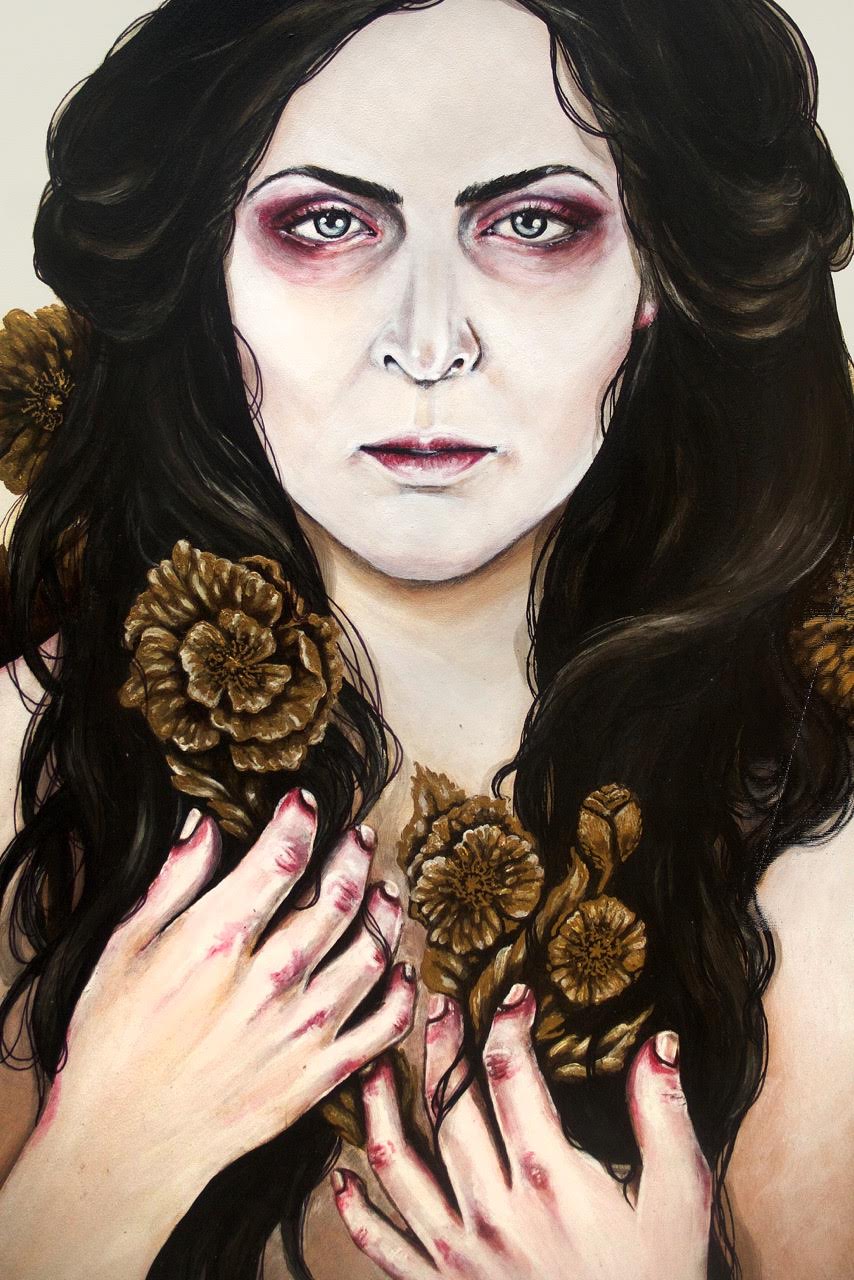Death & the Maiden co-founder, Sarah Chavez, talks to artist AJ Hawkins about her recent series, The Reclamation, which beautifully examines the decomposition of human bodies and the nutrient cycle through art.

Sarah: Could you tell me about your current work, The Reclamation and what led you to creating it?
AJ: The Reclamation is my art series about the decomposition of human bodies and the nutrient cycle. Each piece represents a phase of decomposition, from death to dust, and ways nature reclaims our bodies to foster life. For most, this topic is unsettling and uncomfortable, so I am using science to shed light on the importance and complexity of decomposition, and a creative lens to help beautify the subject and engage viewers who might otherwise look away. By highlighting how life is facilitated by death, I’m hoping we can learn that what we see as an end is actually teeming with potential.

This project was born of my own existential crisis. Until my late teens, I was ardently religious. Though I felt certain of my place in Heaven, I was absolutely terrified of death. I remember being afraid to walk near graves in cemeteries; I remember being afraid to walk across my mother’s cowskin rug. In religious circles, people overlook death, saying what really matters is what comes after. When I very intentionally abandoned religion in my early twenties, I also abandoned my “After.” All of a sudden, death mattered – it was no longer a door, but a destination.
I knew nothing about death but its inevitability – the neurotic part of me worried I would be bad at it. I started to spend all of my free time obsessively studying death, decomposition and the nutrient cycle. I found it to be both elegant and gruesome, complex and beautifully orchestrated – it was a different kind of After, and one that I could be certain of, no matter the state of my spiritual beliefs.


Some of that comfort comes from pulling off the shroud, (pardon the pun), and being more educated about death, some comes from the normalization that occurs when you spend a lot of time with something. Art making, for me, is a kind of meditation and forced closeness. Working on these pieces, I not only have to think about putrefaction, for example, but look at images of it, study its colors and textures, learn about its chemistry, and how that affects its appearance… then spend dozens of hours recreating it in painstaking detail. Once I’ve spent so much time with it and broken it down to its mechanical parts, it’s suddenly not so scary.



AJ: I love that in decomposition, every creature has its place in the process and a unique role to serve. For example, there is a type of moth, Ceratophaga vastella, which has adapted to feed exclusively on keratin – it consumes the horns and hooves of dead animals. It’s cousins in the family Tineidae eat the hair/fur of decomposing bodies. Another example is mushrooms; where a decomposing corpse leaves an area of plant death from pouring high concentrations of nutrients into the soil, (known as a cadaver decomposition island), mushrooms thrive and rebalance the soil, making it ready for other plants to flourish.

AJ: My specific plans are pending my husband’s decision about his own body. (I’m finding that marriage is making me unexpectedly sentimental. My husband recently found me blubbering about whether I should be buried with my wedding ring. Since it felt wasteful burying it, I compromised by having a ring tattooed instead – that way, I’ll carry a mark of my marriage for at least as long as I have fingers). In general, I believe it is unethical to remove my body, and its nutritional value, from the ecosystem, so my wish is to be recycled in the most widely beneficial way possible. I’m an enthusiastic organ donor and would ideally give some of my body to someone who needs it. After that, I’d like to return to the earth, either through recomposition or a natural burial. If it’s appropriate, maybe my family can plant some daisies nearby… I’ve always liked daisies.

3 responses to “Beauty in Decomposition: An Interview With Artist AJ Hawkins”
[…] it’s fascinating 💀 Bring Soup, Not Salad– and other rules for those in mourning. 💀 Beauty in Decomposition: An Interview With Artist AJ Hawkins 💀 Meet the Funeral Therapy Dog Who Helps Mourners Process Their Grief 💀 Passed away, pushing […]
[…] Artist AJ Hawkins uses art and science to highlight how life is facilitated by death. Her stunning artwork examines the beauty that can be found in decomposition and encourages the viewer to face their complex feelings and fear surrounding death. In addition to her art, AJ has created a line of clothing and accessories that are inspired by life and our relationship to death. You can learn more about her here. […]
[…] combining sculpture and painting. They are amazing, and her sensitivity to the balance between death and beauty is inspiring. I can’t wait for the series to finish. Follow all her social media to see the […]